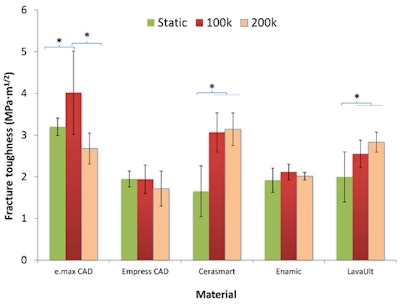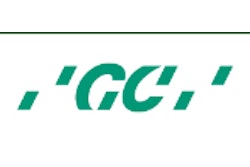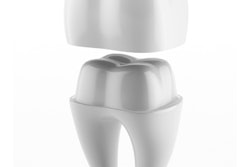
SAN FRANCISCO - When creating restorations using a CAD/CAM process, practitioners want to use the strongest, most fracture-resistant material available. But which material is the most fracture-resistant?
 Alaa Kensara, BDS, DScD, at the IADR annual meeting.
Alaa Kensara, BDS, DScD, at the IADR annual meeting.Researchers tested five contemporary CAD/CAM materials to find out which resisted fractures the best and presented their findings on Wednesday at the International Association for Dental Research (IADR) annual meeting. They found that, of the five materials tested, IPS e.max CAD (Ivoclar Vivadent) had the most fracture resistance.
The research was presented by Alaa Kensara, BDS, DScD, a student in the department of restorative sciences and biomaterials at the Henry M. Goldman School of Dental Medicine in Boston.
"While we saw that fracture toughness increased for several of these materials during our study, we don't yet understand why this is happening," Dr. Kensara said during his presentation.
Fracture resistance
The ability for a material to resist fractures is crucial for the success of a restoration. However, as manufacturers consistently update and improve their materials, results of studies done years ago may not pertain to materials practitioners use today.
“While we saw that fracture toughness increased for several of these materials during our study, we don't yet understand why this is happening.”
The researchers sought to measure the effect of cyclic loading fatigue on five commercially available CAD/CAM materials:
- Lava Ultimate Restorative (3M ESPE)
- IPS Empress CAD (Ivoclar Vivadent)
- Enamic (Vita)
- IPS e.max CAD (Ivoclar Vivadent)
- Cerasmart (GC America)
The researchers prepared 30 polished rectangular bars from mill blocks for each material. They then made a single notch (0.5 mm to 1 mm in depth, 0.5 mm in width) at the center of the nonloading (tensile) edge. Ten blocks of each material were chosen for three tests: static mode (no load on the materials), 100k cyclic loads, and 200k cyclic loads.
Using a cyclic loading machine, the researchers tested fatigue on the specimens in three-point bending mode at a peak load of 40 N and a frequency of 1 Hz. The blocks that survived were then subjected to a three-point flexural test in a universal testing machine. The researchers determined mean fracture toughness (K1C) values using the "single-edge-precracked-beam" method. They defined fracture toughness as the amount of energy required to propagate a pre-existing crack, Dr. Kensara said.
The chart below shows mean fracture toughness of the materials tested in static mode (green), 100k cycles (red), and 200k cycles of fatigue (cream). A higher score is better.
Fracture toughness of 5 CAD/CAM materials

As the chart illustrates, the Cerasmart and Lava Ultimate blocks showed higher values after cyclic loading, while the Empress blocks were not affected by fatigue. Interestingly, the e.max CAD showed higher values and higher variance after 100k cycles but significantly lower values after 200k loading. The Enamic blocks exhibited no significant difference after fatigue compared with the static group.
Other materials
Dr. Kensara noted during his presentation that his group considered this as only the first step in the research and needed to do more studies on materials such as zirconia.
It is important for general practitioners to consider fracture toughness when choosing a restorative material, he told DrBicuspid.com after his presentation.
"It's a matter of understanding how long, generally, each material will last," Dr. Kensara said. "It's important to talk with patients about expectations about how long these restorations will last."



















